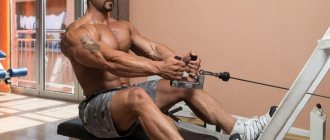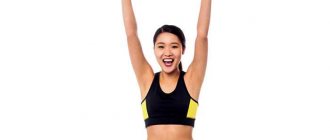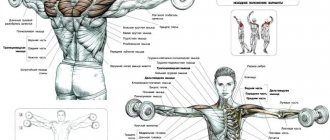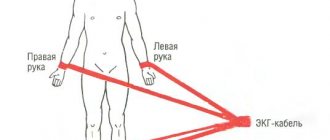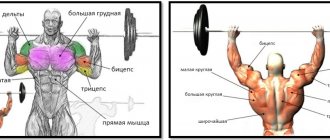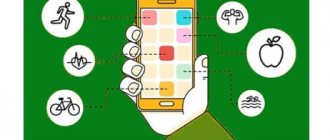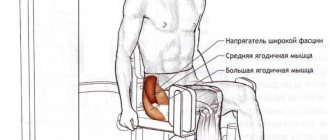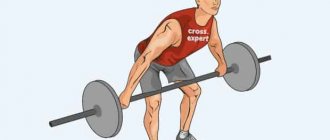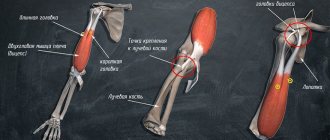The block exercise machine is rightfully considered a universal sports device, with which you can work out almost all the muscles of the body. An excellent effect can be achieved by performing such a basic exercise as a pullover, which separately loads the largest muscles of the back and chest.
Advantages
The pullover is not a basic, but an auxiliary exercise that allows you to give a load to the muscle fibers running from the abdominal muscles to the sides to the arms. Only the vector of movement is directed upward, towards the head, and in all other exercises it is directed to the sides. Thus, the block pullover is an important part of the training process, which has certain advantages over the usual basic movements.
It is known that in earlier times, when exercise equipment was not so varied and people were more patient, pullovers were performed by strongmen with only one purpose - the development of the chest and in the future - the development of powerful breathing to increase endurance.
Nowadays it is customary to train breathing through cardio training, and pullovers are given another function, and a very important one: the formation of muscle relief on the chest and back. That is why pullovers are especially carefully made by athletes who have already gained muscle mass and are now busy polishing their silhouette. To perform them, it is customary to take not the heaviest weights (see below for more details), but perform the movements in full amplitude with the most careful adherence to all recommendations.
Working muscles
The pullover, performed in a standing block, maximally strains the pectoralis major and minor muscles, which is felt already during the first approaches. This does not mean that the pullover only works on the upper chest.
Together with the pectoral, the pullover in the block works the following muscle groups:
- On the back: latissimus muscles;
- diamond-shaped;
- big round one.
- triceps;
- group of anterior muscles of the forearm;
- deltoid muscles of the arm.
The biceps of the arm acts as a dynamic stabilizer during the exercise:
Work of muscles and joints
During a pullover in the simulator, the load is mainly placed on the teres major muscle and the lower part of the latissimus dorsi muscles. The triceps and anterior delta receive part of the load, but these muscles only work as stabilizers and do not need to be specifically loaded. On the contrary, if you choose the wrong angle to perform a pullover, then these muscles will begin to steal the load from the target ones, which is very bad, because then the exercise will be meaningless. Therefore, it is recommended to perform the exercise with a weight with which you can maintain ideal technique. You, of course, must progress the load, since this is the only way to hypertrophy the muscles, but you need to work with the maximum weight that you can control.
Since the pullover in a block is an isolating exercise, it is not difficult to guess that only one joint is working, namely the shoulder. This is another reason not to strive for more weight, because when the load falls on only one joint, it is very easy to injure it. You should also take into account what kind of joint it is! The shoulder joint is the most mobile, and therefore the most fragile joint in the human body. We can twist the shoulder literally in any direction, so moving the joint is not at all difficult. As for the elbow joint and knee joint, although the load should not be placed directly on them, it is better to keep them in a semi-bent state.
General rules
Before starting to perform a pullover on a block, athletes should familiarize themselves with the basic rules of execution. Otherwise, all efforts will not bring the desired result.
Firstly, we must remember that the load will fall correctly only if you position the body correctly in relation to the block.
For example, in order for the exercise to be performed specifically by the latissimus dorsi muscles, and not just by the arm muscles, which is not the purpose of performing a pullover, a number of details must be taken into account and controlled:
- You need to stand facing the machine at a distance of half a step. This is an average distance, and you need to choose one so that you feel the load on the latissimus dorsi muscles.
- Lean forward a little and experiment - at what angle you feel the maximum tension in the target muscles.
- The block should be exactly above your head.
- Don't take too much weight right away. The choice of weight is individual, so the best thing to do is consult with a trainer.
- Feet are shoulder-width apart. You should feel that you are in a stable position.
- Your knees should be slightly bent to allow your back to arch.
- The stomach is pulled in.
- The head is directed straight and slightly upward, towards the block.
- The bar should be held at a width equal to shoulder width, with an overhand grip. Check in advance whether it is comfortable for you to give up.
- Bend your elbows very slightly, relieving tension on the elbow joint.
- Move your arms forward slightly, deviating from the vertical by about 20 degrees.
- Tall people should try doing the exercise on their knees.
- Before you begin, take a breath and tense your back.
Pullover in a crossover
A standing pullover, as well as analog versions of the exercise with free weights, specifically shapes the architecture of the latissimus dorsi muscles and the lower pectoral region. However, the load on the pecs in this exercise is purely nominal and occurs with certain nuances of the technique.
Execution technique
Initial position:
- Stand facing the pulley machine.
- Grasp the handle of the block with an overhand grip, shoulder-width apart, so that your arms are fully extended and at eye level.
- Bend your knees and lean forward slightly, moving your pelvis slightly back.
Movement:
- As you inhale, use your back muscles to lower the handle until it touches your thighs, delaying the peak muscle contraction for 2 seconds.
- Exhale, make a slow and controlled movement back to the level of your head or slightly higher.
Attention!
- At the moment of movement, a natural, visually clear deflection in the lumbar region should be maintained.
- At the moment of peak contraction at the bottom point, tense the working muscles as much as possible, increasing the level of workload.
- To “immobilize” the triceps, you should not allow your arms to bend at the elbow joint.
- The main task is to “cut” the amplitude as much as possible - for this you should not raise your arms too high, unless, of course, the goal of the training is to work the pectoral muscles. The optimal trajectory of the handle movement is from head to hip.
Recommendations!
- Empirically find out what the distance to the rack should be, use different handles - select an individual implementation option in which the contraction of the lats will be most noticeable.
- Adjust the weight load “by feel” - if you feel that the body is involved in the movement, then the weight needs to be lowered.
Execution options
- Pullover on the top block while standing can be performed with either a straight handle or a rope handle. There is not much difference, just individual preferences.
- Raising your arms above your head engages the pectoral muscles.
- Curling your elbows will make your triceps work.
Video Pullover in a crossover
Video Pullover on a block for girls
Analysis of the exercise
Anatomy exercises
The back muscles are more involved, in particular the latissimus. As the range of movement increases, the pectoralis major muscle comes into play, and when the arm bends at the elbow joint, the upper head of the triceps comes into play.
The difference between a basic movement and a crossover exercise
The main part of the load is directed to the spinal muscles. This occurs due to the “shortening” of the amplitude of movement in the upper load vector. The same condition makes it possible to use greater weights when performing a pullover on a block.
Benefits of standing pullover exercises with free weights
- When performing a pullover in a block simulator, it is much easier to shift the focus of attention to a specific muscle group and make it work as isolated as possible. Thus, a pullover in a crossover is the only traction exercise in which it is possible to completely turn off the assisting muscles from work and focus on contracting the latissimus dorsi muscles.
- Performing the exercise in the simulator allows you to eliminate the traumatic load on the shoulder joint - there is simply no unnatural “starting” movement of the arms, during which the articular joint is extremely loaded.
When to perform a crossover pullover
- Option 1: Just like other modifications of the pullover, this exercise is performed after a basic load on the muscle for more powerful stimulation and refinement.
- Option 2: A pullover on the upper block can be used to pre-fatigue the working group, that is, at the end of training the back muscles.
Who is it suitable for?
A universal version of the exercise that is suitable for both beginners and experienced athletes. Tall athletes may experience discomfort when performing the exercise - in this case, it can be replaced with an alternative version of the “block” pullover from a sitting or kneeling position.
Muscle map
Source: upraznenia.ru
This is interesting: Pulling a barbell to the belt is simple and scientific - we explain the question
Step-by-step technique
Despite the fact that the pullover does not look like a difficult exercise, you should take the technique seriously:
- Start moving your arms downwards, pulling the block away with tension. Try to fix your joints so that the main load is carried out by the muscles of your back and chest.
- At the same time, exhale.
- Slowly move your hands down to your hips.
- At the bottom, pause for two seconds. Feel the tension in your back and chest, feel that you are sufficiently tense all the stated muscle groups.
- Exhale at the bottom and as you begin to move up, begin to inhale. At the top point, exhale again.
- Start moving your arms up, keeping your muscles tense.
At the end of the work, you should feel a noticeable burning sensation in the muscles. Gradually move up to heavier weights.
In the video clip you can clearly see how to correctly perform the pullover exercise on a block. And also, find out the main points of implementation that the trainer talks about:
Pullover near the block on the simulator
What muscles work in the pullover exercise on a block?
· » Basic:
latissimus dorsi
· » Auxiliary:
pectorals, triceps, deltoid
How to do a pullover correctly in a block simulator
Good day, our dear readers. Today we will learn how to do a specific exercise to develop the back muscles - a standing pullover or a pullover on a block simulator, a pullover in a crossover. The mechanics of movement is bringing the arms to the body.
During the exercise, various muscle groups are involved in the work. This includes the back, chest and arms. Therefore, depending on the specifics and variations of the technique, the load can be emphasized on individual groups. Our task today is to pump up the back - so we will learn how to do a pullover at the training block with an emphasis on the lats.
How a pullover in a crossover looks in motion
Technique
Let's dwell on the technique and find out why, when performing a pullover, the load is focused on the back muscles?
Hand position. The load falls on the back and does not leave it thanks to the positions of the arms throughout the entire range of motion, and especially at the top. Without raising our arms very high, we constantly strain our back. In a regular pullover, the hands go far behind the head at the top point. That is, we work our arms, biceps, then our chest, and then our back, it turns on at a certain point. Here we shorten the amplitude of the movement and leave only the phase that is responsible for the work of the lats.
Back position. When doing a crossover pullover, as in all back exercises, the lower back should be slightly arched and the back straight. As for the chest, it should be slightly inflated and, as it were, pushed up. When there is a natural deflection in the lower back, this allows the back muscles to contract correctly.
Knees. When performing lat pulldowns with straight arms, you need to squat down - bend your knees. With your knees bent, it is easier to work your back and contract your back muscles.
Hands. Hands must be fixed throughout the entire range of motion. They do not need to be raised high or bent at the elbows to imitate a French bench press. It is necessary to achieve a position of the hands where movement in the elbow joint is close to a minimum. This is the connecting link; all the work is transferred to the back muscles. So that it doesn’t turn out that by pumping up your lats, you pump up your arms.
Top and bottom point
. At the lowest point of the amplitude, you need to linger for a couple of seconds and strain your back with additional effort. This is the so-called peak contraction. At the top, on the contrary, you need to stretch your lats, but do not throw your arms, do not let them go up by inertia. Maintain an average position, approximately parallel to the floor, maybe a little higher.
More on the back:
Upper pulley to chest
Distance to projectile. In order for the back muscles to contract as efficiently as possible while pulling the upper block with straight arms, it will be necessary to conduct several experiments regarding the distance of the body from the projectile. The load on your back will change as you move closer or further away from the crossover block exercise machine.
Angles of inclination, handles. The same is with the angles of inclination, a little lower, a little higher. Try different handles. Some people will feel comfortable doing it with a straight handle, others with a bent handle. Third, they will use a rope handle, parallel or V-shaped, in the pullover. That is, there are a lot of options - you need to try.
Execution Sequence
1. Take the starting position - facing the block simulator
2. Take the bar and handle with a comfortable grip, take a step back
3. Slightly bend your elbows and tilt them forward 20 degrees from the vertical in order to lift the load off the ground.
4. Bend at the waist, keep your back straight and straight, bend your knees
5. Inhale, tightening your lats, and begin to pull the bar towards your body with straight arms, up to your hips.
6. At the bottom, pause and additionally strain your back muscles, focus the load on them
7. Smoothly release the handle without straightening your arms or changing the position of your back and legs to the starting position.
8. At the very top, try to stretch and stretch your back muscles even more, bend over, exhaling even more strongly.
Position 1
Position 2
Errors
» Using the force of inertia and swing. You need to perform the exercise smoothly, without jerking or swaying.
» Do not round your back and shoulders when pulling a pullover at the crossover block. Remember, the back loves an arched lower back and vertical
“The body should not walk from side to side or back and forth. Keep yourself still and fixed at all times.
Number of approaches and repetitions
» For men: 15 - 20 repetitions 4 sets.
» For women: 15 - 20 repetitions 4 sets.
How can you replace a pullover standing next to a block?
The exercise, one-arm dumbbell row in an inclined position, will be similar in load.
Pullover near a block crossover standing video
conclusions
In order to pump your back in the pullover exercise on a block simulator, you need to experiment a lot with angles, distance from the apparatus, handles, and hand position. The exercise is very difficult from a technical point of view; not all professionals do it correctly. You need to choose an individual form of performing the exercise so that only your back works, other muscles are excluded.
Source: force-man.ru
How many times should you do it and when?
Pullover should start with small but long-lasting loads: in each set - from 12 to 20 repetitions, at least three approaches, and preferably five. Moreover, women are recommended to use almost the same regimen: 4 sets of 15-20 repetitions. But women should take lighter weights and not strive for maximum loads.
The best time for a pullover is in the final part of the training process, after you have finished the most difficult, basic exercises. The second option, also quite effective, is to train the latissimus and pectoralis just before starting sets for the back muscles. Isolated training of the latissimus muscles allows you to prepare your back for serious stress.
Pullover on block
The standing pullover is the only isolated exercise for the latissimus dorsi muscles. In other other pulling exercises, the biceps are necessarily involved, but the pullover in the crossover solves this problem, allowing you to purposefully, point load the back.
If you do a pullover with dumbbells, then due to the fact that the dumbbell goes behind the head, we greatly stretch the pecs, and due to the fact that with a dumbbell it will not be possible to keep your arms completely straight, otherwise the load will be placed heavily on the shoulder joint, then the lion's weight falls on the triceps load share. A pullover on a block is free of these problems, because... there is no need to put the weight behind the head, and all the work happens in front of us, we can also calmly keep our arms straight, and there will be no breaking load on the shoulder joint. All these nuances allow you not to strain or think about other muscles, but only to train the latissimus, but provided that you do everything correctly.
Technique for performing a pullover in a standing crossover
1. As with any other back exercise, it is very important to maintain a bend in the lower back in order to maximize the contraction of the latissimus dorsi muscles.
2. Keep your arms straight and do not bend them at the elbows, otherwise the triceps will be heavily loaded.
3. The starting position should be such that the handle is at eye level; if you move it higher, your chest will engage. Final position - pull the handle as far as possible towards you, so that it touches your legs, and bring your shoulder blades together.
4. Try not to grab the handle, but put your hands on top of it, this will allow you to relax your hands and load only the lats.
5. Experiment with the handles; for some, a straight handle is suitable, for others, a curved handle, while others feel better with a rope handle. You must find yours, which allows you to feel the target muscles more.
6. Experiment with lift height and amplitude, because... Everyone’s structure is different, try raising the handle higher or lower, also try standing closer or further to the machine. All this is aimed at finding exactly your optimal technique.
When to perform a pullover in a crossover?
1. At the end of the workout after basic exercises. This will allow you to finish off your back muscles, while not touching very tired biceps after pulling exercises.
2.At the beginning of back training. If during pulling movements your biceps take the lion's share of the load, and your back remains fresh at the end of the exercise, then perform a pullover before pulling. This will allow you to load the lats in isolation, and then when you move on to basic exercises, your back will fire faster than the biceps, which is basically what we want.
We do 3-4 sets of at least 12 repetitions and up to 20. Since this is not a multi-joint exercise, there is no need to chase weights, the point here is to precisely get where you need to go. Isolated exercises do not grow muscles; they serve completely different purposes. Either this is preliminary fatigue, or the refinement and detailing of the muscles after the main exercises.
Source: xn--80akhbn8afi6b1c.xn--p1ai
This is interesting: Sports bars - types of sports bars, quality criteria, recipe for homemade sports bars
